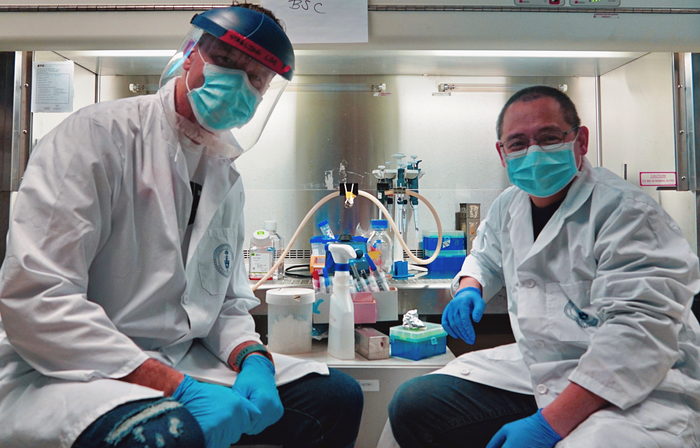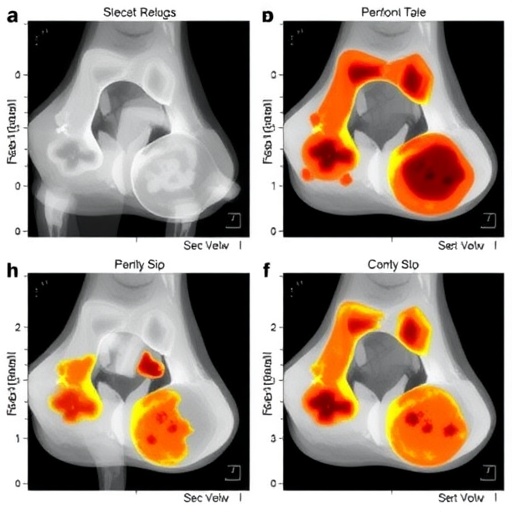The experts agree — the pandemic is not over. Infections are ticking up again, fueled by the new variants our immune systems are ill prepared for.

Credit: Stagljar lab, University of Toronto
The experts agree — the pandemic is not over. Infections are ticking up again, fueled by the new variants our immune systems are ill prepared for.
That’s according to a study by Canadian and US researchers who found that the antibodies generated in people who were vaccinated and/or recovered from COVID-19 prior to 2022 failed to neutralize the variants circulating today.
The study was led by Igor Stagljar, a professor of biochemistry and molecular genetics, at the Donnelly Centre for Cellular and Biomolecular Research, at Temerty Faculty of Medicine, and Shawn Owen, an associate professor of pharmaceutics and pharmaceutical chemistry, at the University of Utah.
The journal Nature Communications published their findings.
The researchers expect that the antibody test they developed to measure immunity in the study’s participants will become a valuable tool for deciding who needs a booster and when, which will help save lives and avoid future lockdowns.
“The truth is we don’t yet know how frequent our shots should be to prevent infection,” said Stagljar. “To answer these questions, we need rapid, inexpensive and quantitative tests that specifically measure Sars-CoV-2 neutralizing antibodies, which are the ones that prevent infection.”
Many antibody tests have been developed over the past two years. But only a few of the authorized ones are designed to monitor neutralizing antibodies, which coat the viral spike protein so that it can no longer bind its receptor and enter cells.
It’s an important distinction, as only a fraction of all Sars-CoV-2 antibodies generated during infection are neutralizing. And while most vaccines were specifically designed to produce neutralizing antibodies, it’s not clear how much protection they give against variants.
“Our method, which we named Neu-SATiN, is as accurate as, but faster and cheaper than, the gold standard, and it can be quickly adapted for new variants as they emerge,” he said.
Neu-SATiN stands for Neutralization Serological Assay based on split Tri-part Nanoluciferase, and it is a newer version of SATiN, which monitors the complete IgG pool, which they developed last year.
The development of Neu-SATiN was spearheaded by Zhong Yao, a senior research associate in Stagljar’s lab, and Sun Jin Kim, a postdoctoral fellow in Owen’s lab, who are the co-first authors on the paper.
The first of its kind, the pin prick test is powered by a protein-complementation strategy using the fluorescent luciferase protein from a deep-water shrimp. It measures the ability of the viral spike protein to bind the human ACE2 receptor, each of which is attached to a luciferase fragment. The binding brings the luciferase pieces into proximity so that they reconstitute a full-length protein, which gives off a glow of light that is captured by the luminometer instrument. When patient blood sample is added into the mixture, the neutralizing antibodies will bind the spike protein, preventing it from contacting ACE2. Consequently, luciferase remains in pieces, with an accompanying drop in light signal. The plug and play method can be adapted to different variants within a couple of weeks by engineering variant mutations into the spike protein.
The researchers applied Neu-SATiN to blood samples collected from 63 patients with different histories of COVID-19 infection and vaccination up to November 2021. Patient neutralizing capacity was assessed against the original Wuhan strain and the variants, Alpha, Beta, Gamma, Delta and Omicron.
“We thought it would be important to monitor people that have been vaccinated to see if they still have protection and how long it lasts,” said Owen, who did his postdoctoral training in the Donnelly Centre with distinguished bioengineer and University Professor Molly Shoichet. “But we also wanted to see if you were vaccinated against one variant, does it protect you against another variant?”
The neutralizing antibodies were found to last about three to four months when their levels would drop by about 70 per cent irrespective of infection or vaccination status. Hybrid immunity, acquired through both infection and vaccination, produced higher antibody levels at first, but these too dropped significantly four months later.
Most worryingly, infection and/or vaccination provided good protection against the previous variants, but not Omicron, or its sub-variants, BA.4 and BA.5.
The data match those from a recent UK study, which showed that both neutralizing antibodies and cellular immunity, a type of immunity provided by memory T cells, from either infection, vaccination, or both, offered no protection from catching Omicron. In a surprising twist, the UK group also found that infections with Omicron boosted immunity against earlier strains, but not against Omicron itself, for reasons that remain unclear.
It’s important to stress that vaccines still confer significant protection from severe disease and death, said Stagljar. Still, he added that the findings from his team and others call for vigilance in the coming period given that the more transmissible BA4 and BA5 sub-variants can escape immunity acquired from earlier infections with Omicron, as attested by rising reinfections.
“There will be new variants in the near future for sure,” Stagljar said. “Monitoring and boosting immunity with respect to circulating variants will become increasingly important and our method could play a key role in this since it is fast, accurate, quantitative and cheap.”
His lab is already collaborating with the Canadian vaccine maker Medicago to help determine the efficacy of their vaccine candidates against Omicron and its subvariants. Meanwhile, U of T is negotiating to license Neu-SATiN to a company which will scale it up so that it can be used for population immunosurveillance and in the pharmaceutical industry for vaccine development.
DOI
10.1038/s41467-022-31300-9
Method of Research
Experimental study
Subject of Research
People
Article Title
Homogeneous Surrogate Virus Neutralization Assay to Rapidly 1 Assess Neutralization 2 Activity of Anti-SARS-CoV-2 Antibodies
Article Publication Date
1-Jul-2022





